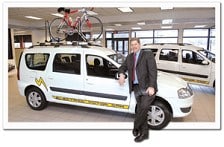Iowa-assembled electric cars surging toward production

The sight of Iowa-assembled electric vehicles on the road is coming closer and closer to reality.
The most important thing, though, is making sure the vehicles are ready – completely ready – before they hit the market, said Gene Gabus, head of Electric Motor Cars of Des Moines, which will manage dealership distribution of the vehicles and sell them, too.
“Your focus is on getting it right before you sell it – totally right. Is it going to be perfect? No. Is it going to be as close to being perfect as we can make it without wasting any more time? Yes,” Gabus said. “We just need to make sure we don’t run into problems as we start producing them. … We come up with recalls, everything else, it could kill the vehicle before it gets off the ground.”
That’s the challenge for the family of vehicles imported by New York-based Electric Mobile Cars Inc. Ames-based EnVision Motor Co. is the sole distributor of the vehicles, and has worked with Gabus and EMC to manufacture a chassis and parts to create three electric vehicles: a station wagon, a cargo van and a pickup truck. The vehicles will be assembled by Webster-City-based American Motor Systems Inc.
The vehicles, once manufactured, will be sold in Des Moines and distributed to dealers across the country.
Getting from idea to road-ready hasn’t been without its bumps, but neither Gabus nor EnVision President Thomas Gleisner seem worried about delays. Gleisner estimated select dealerships will have a model version of the cars within 30 days, and Gabus estimated the first car could be sold within 90 days.
Taking it slow
Things have come a long way since Gleisner thought of the idea while driving a low-speed electric vehicle around Ames during the summer of 2008, when gas prices hovered around $4 per gallon.
The final part of the process of getting vehicles ready to be sold has been a little slower than expected. Gleisner and Gabus originally expected to have road-ready vehicles by last fall, but enter 2011 still waiting to sell the first car.
That’s OK, they said.
“Do I wish we were selling these cars? Yeah, because that’s how I make money,” Gabus said. “I’m not making any money right now, I’m just spending money. But when it does hit the market, for what people are saying they want, this car should fit the bill perfectly.”
Added Gleisner, “No, it hasn’t gone as fast as we wanted it to. … In a project like this, things never go according to time schedule. I think for the time we spent on it, and the size of our corporation, we are probably ahead of the game.”
A big part of the delay has been the supply chain management. The Renault-made Dacia Logan chassis are being imported from Romania, and the electric motors and assembly parts are being manufactured separately in the United States. Asking manufacturers to make custom parts for the vehicles has provided an extra challenge, Gleisner said.
Beyond that, challenges come with manufacturing three types of vehicles instead of just one, which was a sacrifice the distributors were willing to make.
Now, though, bodies are in the United States, and drive train parts are flowing in, making Gleisner feel a lot more optimistic about making major forward progress in the next three months.
Gabus said they are waiting on three parts, scheduled to arrive early in the new year, to be able to complete the main battery on the test car. Once that is complete, Gabus will test the car himself before completing any sales to dealers.
“We need to make sure that we’ve got everything done, and that we’ve tested it and tested it harder than what the normal person is going to drive it, and that we make a vehicle that is going to pass,” Gabus said. “What we’re doing takes time.”
Dealers show interest
So far, between 300 and 400 dealers have expressed interest in selling the electric cars, Gleisner said. That list will be whittled down to network of around 150 to start.
The first 100 vehicles produced will go to dealers as demos. By early spring, Gleisner hopes to have 1,000 cars in production.
“I don’t think you’re going to see these vehicles sitting at a dealer’s lot for sale right away,” he said. “I think, because of the numbers, it’s going to be an order situation for quite a while.”
After that, the goal is to eventually manufacture up to 2,500 vehicles per month in Iowa and cap off production at 60,000 cars per year after opening another assembly facility.
Gabus said two or three customers a day come into Des Moines Motors, where Electric Motor Cars is located, to take a look at the floor model. People were also able to test drive a working electric van that was in the showroom last year.
“We’ll be able to sell everything we make for a long time, until our numbers get to be really, really big,” Gleisner said.
“A solid, solid vehicle”
The vehicles themselves are designed to resemble a gas-powered car both in the way they drive and the way they look. Gleisner’s goal is to not have bystanders even notice the car is different.
The three vehicles will get up to 75 miles per hour highway speed, and “will get you in trouble in town” if you so choose, Gabus said.
“This is a solid, solid vehicle,” he said. “People that are buying electric cars – is it fancy, is it curvy? No. But they don’t care. It’s practical.”
The wagon is priced at $37,300, the van at $32,300 and the truck at $33,300. Gabus advertises that the initial prices might be higher, but customers can make up the difference in the long run.
He estimates the fuel cost for driving 15,000 miles per year for four years in a gas-powered minivan to be $9,648, based on gas prices of $2.75 per gallon. The EMC wagon will only cost $992 over the same period.
The electric vehicles, he emphasized, are good for people who drive a lot on a daily basis, as the batteries are expected to get up to 200 miles per charge. Manufacturers say the battery is good for at least 1,000 charges, and it will be warranted for 100,000 miles.
“And if you are getting at least 150 miles (per charge), there’s 150,000 miles that the battery is good for,” Gabus said.
Now it’s just a matter of getting them ready to sell.
“We’re in a good position now,” Gleisner said. “Now the flow has started.”











